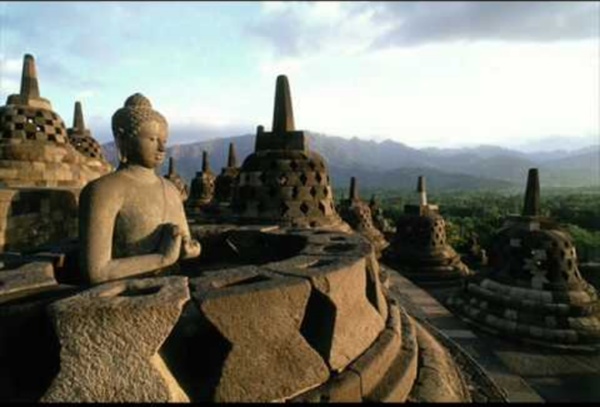



http://www.youtube.com/watch?v=fl4VNvAVeJA
The Music of Indonesia A subtly glowing array of bronze ingots, pots, and gongs in intricately carved wooden cases painted indigo and red with flashes of gold leaf—this was the dazzling sight that greeted us, a small group of university students and faculty who had come to the Field Museum in Chicago for an afternoon's introduction to the performance of gamelan music. Gamelan — an Indonesian word meaning "musical ensemble"— can be variously constituted, but the one at the Field Museum is representative of those used at the princely courts on Java, the most heavily populated island in the nation of Indonesia. Nowadays, similar gamelan are to be found in many universities and colleges in the United States and Europe.
Museum of International Folk Art Gamelan is an Indonesian orchestra that mainly consists of percussion instruments such as gongs and metallophones. Female singers (pesindhen) and a male chorus (penggerong) are also involved in a complete ensemble. In Indonesia, particularly on Java and Bali, gamelan is an essential accompaniment for wayang performance and other dramatic forms. Gamelan is also enjoyed as an element of ritual celebrations such as wedding receptions, circumcisions, and village ceremonies. New contexts for gamelan have developed over the years; today there are special performances for Indonesia’s Independence Day, radio and television programs, and informal “jam” sessions that are occasionally sponsored by gamelan patrons and connoisseurs. Important aspects of gamelan performance practice include the tuning system (laras) and modal classification (pathet).
Smithsonian Folkways - Music of Indonesia Series A collaboration with the Society for Indonesian Performing Arts This acclaimed 20-cd series documents the music of the Indonesian archipelago, introducing listeners to dozens of beautiful and varied musical styles from throughout this complex island nation. Guitars and gamelans, flutes and drums, voices and brass bands contribute to this musical treasure trove that the New York Times called "monumental and enjoyable." Indonesian scholar Philip Yampolsky worked from 1991-1999 with the Indonesian Society for the Performing Arts and Smithsonian Folkways Recordings to produce this remarkable series. Traveling to congested cities and remote rural areas, Yampolsky and his Indonesian colleagues used state-of-the-art digital equipment to create these beautiful recordings that will appeal to expert and novice alike. Eachcontains more than an hour of music and extensive annotation that places the performances in their regional and national contexts.
History of Gamelan Indonesian Music and Dance Across Indonesia, but particularly on the islands of Java and Bali, gamelan is the most popular form of traditional music. A gamelan ensemble consists of a variety of metal percussion instruments, usually made of bronze or brass, including xylophones, drums, and gongs. It may also feature bamboo flutes, wooden stringed instruments, and vocalists, but the focus is on the percussion. Indonesian popular music recordings Recorded music is a reflection of modern Indonesian history and culture—specifically class consciousness, economics and post-colonial identity. Since the early 1970s, the production, marketing and distribution of recorded media, particularly popular music cassettes and VCDs, in Indonesia have evolved in tandem with the archipelago's ongoing integration of tradition and modernity. History[edit] Central to the ongoing evolution of Indonesian popular music styles was an inherent tension between dueling aesthetics: gedongan ("refined", "international") and kampungan ("vulgar," "low class," "backward"). During the 1970s, the most prominent supporter of the gedongan style was Guruh Sukarno (born 1953), son of the first president of Indonesia and a musician since his early teens.
13 Most Famous Musical Instruments in Indonesia - Facts of Indonesia There are so many languages in the world because each country has different language with the others. That is why there are sayings who said that music is a universal language which can touch and unite people no matter where that music comes from. Have you ever liked a song even though you do not understand its language? that is a concrete example that music is a universal beauty which does not have to be said. Music instrument has a magical touch to make the song sounds beautiful. Here are some Indonesian music instruments from Indonesia which amaze the world.